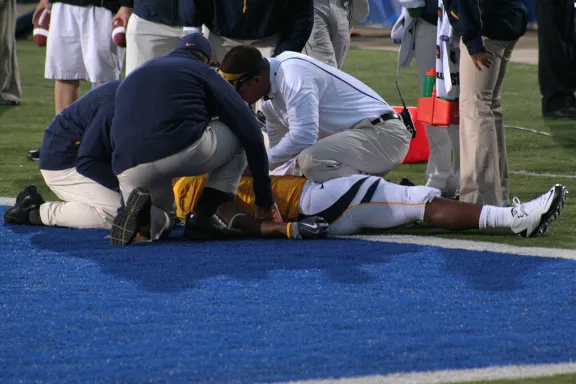
The Super Bowl of Concussion Diagnoses
When Dr. Mitchel Berger watched the Super Bowl last Sunday, he wasn’t watching the plays, the catches, and the many, many interceptions. He was watching the hits.
“This is what we do in a concussion clinic—they’re not players, they’re patients.”
As the Unaffiliated Neurological Consultant (UNC) on the winning Denver Broncos’ side, it was Berger’s job to evaluate players that take those hits for signs of brain trauma or concussion. As chair of UCSF’s Department of Neurological Surgery, working the Super Bowl was a little different from Berger’s regular clinical and surgical routine. It is work that he relishes, however, and not because he gets field-level seats to the biggest sports event in the country. As a member of the NFL’s Head, Neck and Spine committee, he is intensely focused on player safety in a game that is anything but.
Berger is a tall, well-built man, who was wearing casual clothes and a UC Berkeley t-shirt in his office when we met. Overlooking the north side of campus, his office was comfortable and decorated with achievements, most notably the number of Super Bowl VIP passes draped over an obsolete X-ray light box. When asked, Berger explained the role of the UNC with his surgeon’s precision.
Medical evaluation begins when a player suffers a bad hit. Sometimes the injury is clear-cut; if the player loses consciousness or suffers amnesia, they are immediately made to sit out the rest of the game, per regulation. Other times, a medical time-out is called from an unaffiliated athletic trainer who sits above the field and observes play. Once this halt is called, the player goes to the sideline for an evaluation. This is where Berger comes in.
The diagnosis of concussion can be tricky in the best of clinical scenarios, and, with the on-field evaluation, Berger describes the environment as “sensory overload.” The crowd, the cameras, and adrenaline from the game can all contribute to a difficult neurological and physical exam. Berger explained that, to play it safe, if a player exhibits any signs or symptoms of concussion during the on-field evaluation, they are immediately brought off the field for further testing. This is called the “Madden rule,” named after the suggestion of former player and coach John Madden.
Berger explained that taking players to the locker room helps the accuracy of the diagnosis, but players may not thank you for it.
“I would say that the vast majority [of patients] are very compliant, and understand that this is the rule.” However, “Some players use expletives, and tell me to ‘take a hike.’”
Two players on the Bronco’s side were evaluated by Berger on Sunday; Berger would not disclose their names because of patient confidentiality. One of them was brought to the locker room for further evaluation. Subjectively, Berger looked for symptoms of vertigo, nausea and dizziness; objective findings include a loss of balance and nystagmus. After evaluation by Berger and the Broncos’ medical team, the Broncos’ player was released for play. A player on the Carolina side was not as lucky.
As well as keeping patients safe and providing the best health care possible, Berger sees his time working as a UNC and with the NFL in general as giving back to a sport that gave a lot to him.
A football player at his undergraduate institution, Harvard, Berger tried out for the Chicago Bears, but was stymied by a bad knee and finger injury. However, he was adamant that the sport changed his life. Berger cited the lessons in teamwork, discipline, perseverance, and physical fitness that football imparted to his medical career.
“It got me where I am today.”
Concussions and general brain trauma are currently at the center of a high-profile controversy involving the NFL, especially as reported concussion rates have been rising over the past year. Berger says that rise is due to “increased vigilance” from healthcare providers and more self-reporting by players. He stresses that recent rule changes, such as moving kickoff from the 30- to the 35-yard line, will show results, and that the game is changing.
“Football is a sport in evolution. In 20 years, [the game] will look different than now.” Berger admits that some things will not change, however. “It will always be a very physical game. You’re never going to eliminate risk.”
Asked whether he would let his kids play football, Berger did not hesitate.
“Absolutely. No question. It got me to where I am today.”


